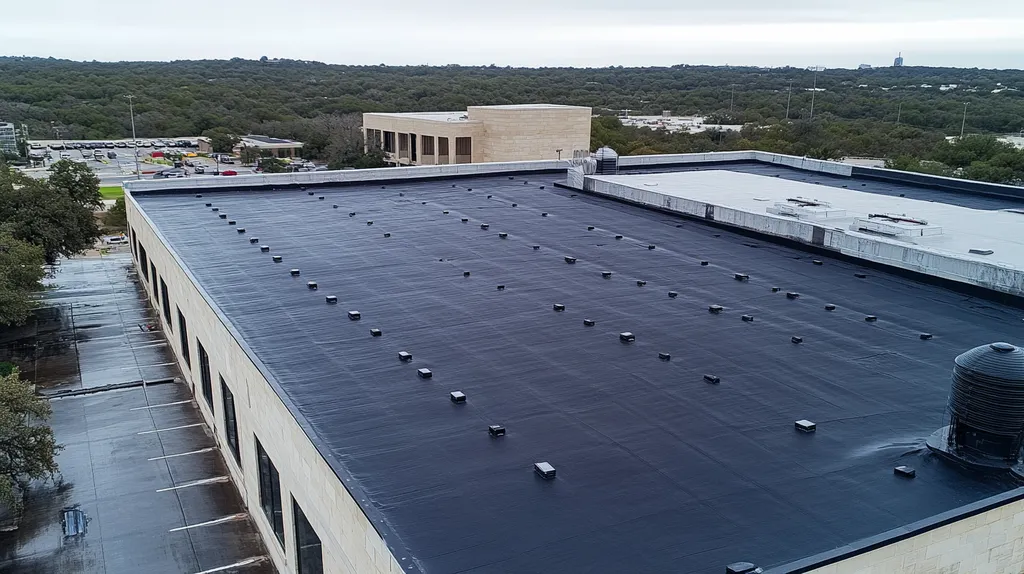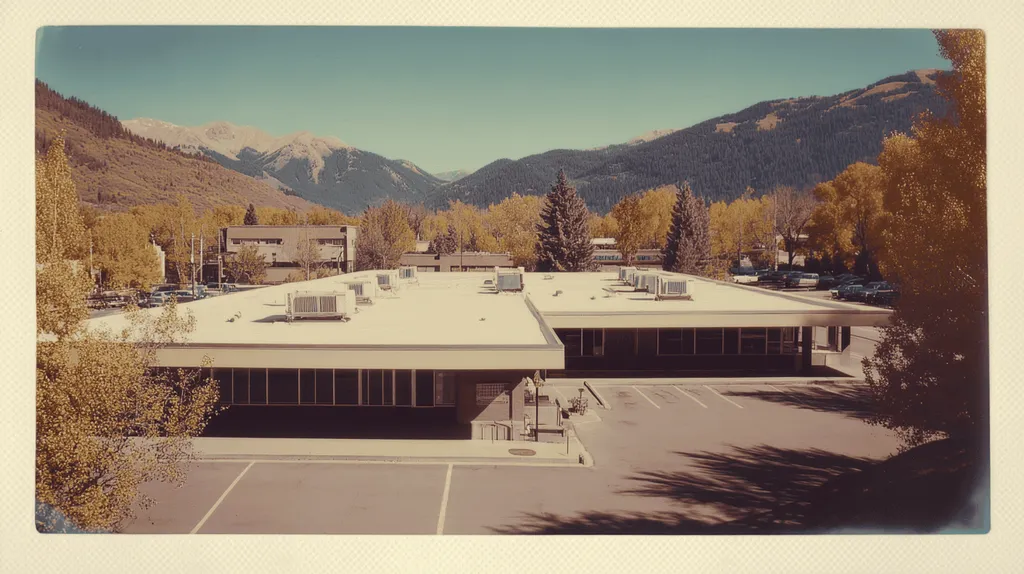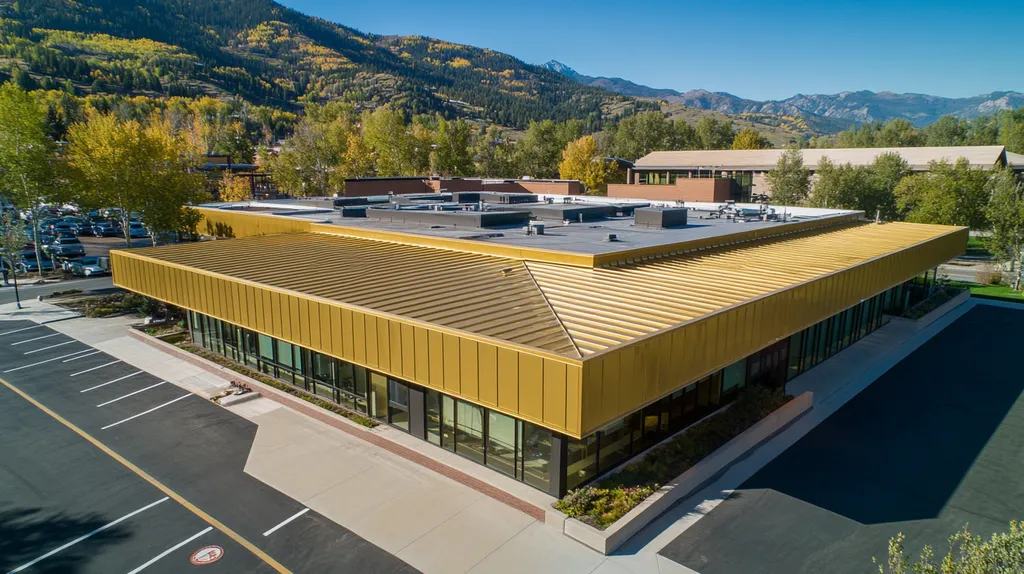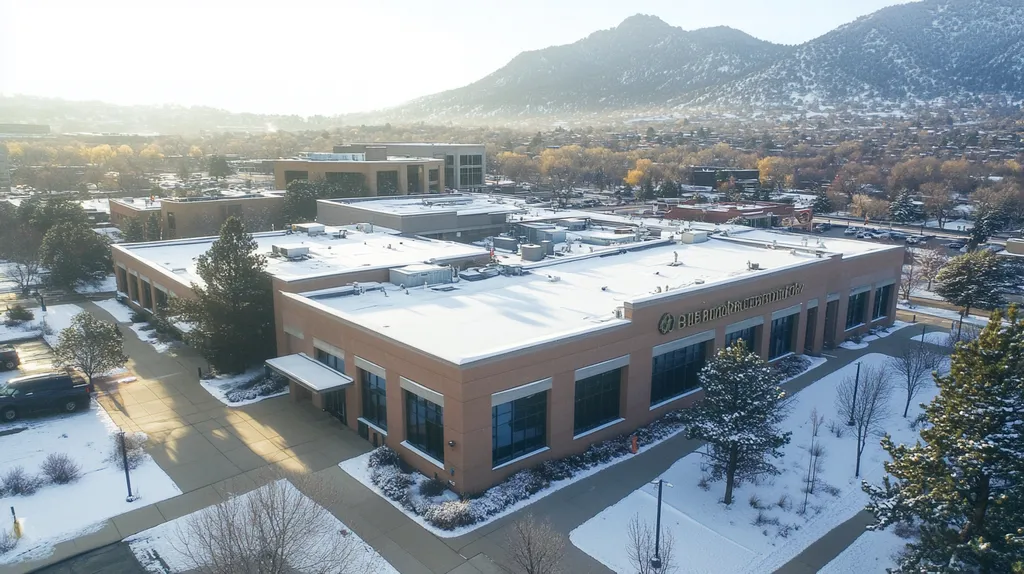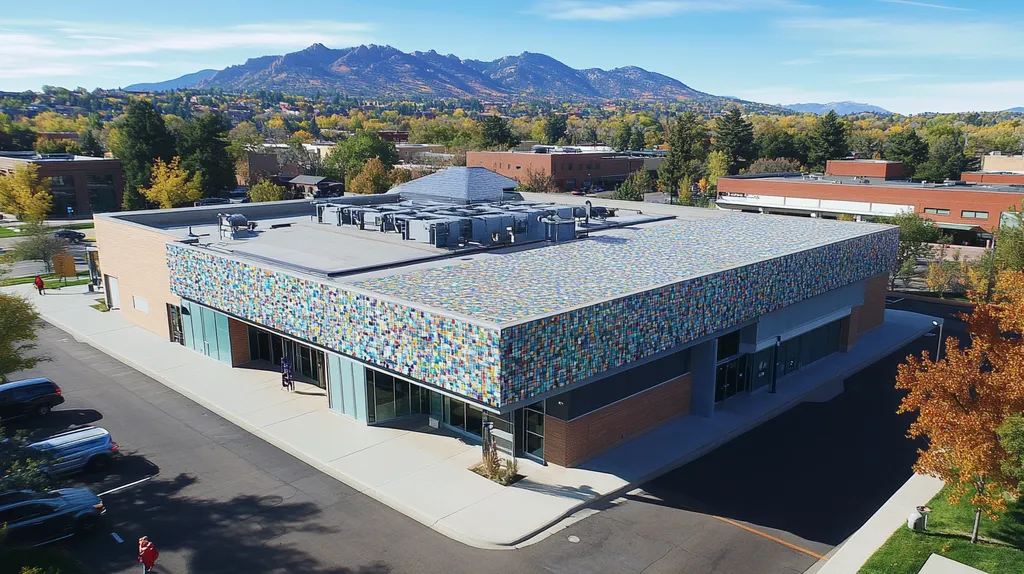Commercial roof coating failures cost U.S. businesses over $2.3 billion annually in repairs and operational disruptions, yet conventional application practices remain largely unchanged for decades.
Recent industry data reveals that 40% of coating installations fail prematurely due to outdated methods and systemic quality control issues.
This analysis examines why traditional coating approaches consistently underperform, exploring critical gaps in current practices while identifying emerging technologies and methodologies that promise superior long-term performance.
SECTION 1: CURRENT PRACTICES
The urgency of effective roof coating practices cannot be overstated. A recent industry report revealed that improper coating can reduce roof lifespan by up to 50%. This statistic underscores the stakes involved in selecting the right materials and protocols.
Commercial property owners face increasing pressure to maximize roof performance while minimizing operational disruptions. In this section, we examine current coating practices, from material selection to maintenance procedures, revealing why conventional approaches often fall short.
Predominant Roof Coating Materials and Applications
Today’s commercial roofing market offers several coating options, with acrylics, polyurethanes, and silicone-based products leading the field. Each material presents distinct advantages and limitations that significantly impact long-term performance.
While acrylic coatings dominate due to their cost-effectiveness, they often underperform in ponding water conditions. Polyurethane coatings offer superior durability but require more precise application conditions.
Material selection must account for local climate conditions, roof substrate type, and building use patterns. Many coating failures stem from mismatched materials rather than product defects.
The rise of cool roof requirements has pushed white and light-colored coatings to the forefront, though proper application remains crucial for achieving advertised benefits.
Typical Installation Protocols and Industry Standards
When applying primers, contractors must maintain thin, consistent coats with complete curing periods of 2-4 hours in summer conditions. Base coats require careful overlap patterns to prevent thin spots, while most acrylic coatings demand 12-24 hours between applications. (source: Paramount Building Inc.)
Surface preparation remains the most commonly skipped step in coating applications. Many contractors rush through cleaning and primer stages, compromising the coating’s adhesion potential.
Temperature and humidity significantly impact coating success. Installation should occur between 50-80°F with humidity below 85%, yet many projects proceed under suboptimal conditions.
Quality control measures often focus on coating thickness while neglecting crucial factors like surface temperature and dew point calculations.
Common Maintenance and Recoating Procedures
Current maintenance practices typically revolve around annual inspections, though many facilities extend this interval to reduce costs. This approach often results in missed early warning signs of coating failure.
Recoating decisions frequently occur reactively, after visible problems emerge. This pattern leads to higher repair costs and increased disruption to business operations.
Standard maintenance protocols often overlook critical inspection points like seam integrity and flashings. These oversights accelerate coating degradation and reduce system longevity.
Many facilities lack documented maintenance procedures, relying instead on institutional knowledge. This gap creates inconsistent care patterns and complicates long-term performance tracking.
The industry’s shift toward preventive maintenance remains slow, with many properties still following outdated reactive maintenance models.
SECTION 2: SYSTEMIC ISSUES
The commercial roofing industry faces critical systemic challenges that threaten long-term roof performance and business continuity. Recent studies show that over 40% of coating failures stem from systemic issues rather than material defects. Property owners often discover these problems only after significant damage has occurred, leading to costly repairs and business disruptions.
Understanding these systemic issues is crucial for making informed decisions about roof coating investments and maintenance strategies. This section examines the three primary challenges: quality control deficiencies, regulatory limitations, and durability concerns.
Quality Control Challenges in Coating Application
Quality control during coating application represents one of the most significant challenges facing commercial property owners. Temperature and humidity monitoring, material thickness verification, and proper surface preparation all require constant vigilance throughout the application process.
Proper application demands strict adherence to manufacturer specifications for primer application, base coat overlap patterns, and curing times between coats. Many coating failures occur when contractors rush these critical steps or work in suboptimal conditions.
When applying primers, contractors must maintain thin, consistent coats with complete curing periods of 2-4 hours in summer conditions. Base coats require careful overlap patterns to prevent thin spots, while most acrylic coatings demand 12-24 hours between applications. (source: Paramount Building Inc.)
The lack of standardized quality control protocols across the industry leads to inconsistent results. Many contractors rely on visual inspections alone, missing crucial measurements that could prevent future failures.
Limitations of Current ASTM and Building Codes
Current building codes and ASTM standards often lag behind technological advancements in coating materials. This gap creates confusion for property owners trying to select the most effective solutions for their facilities.
Many innovative coating products face lengthy approval processes before gaining code acceptance. This delay prevents property owners from accessing potentially superior solutions that could extend roof life and reduce maintenance costs.
The absence of unified performance standards across jurisdictions complicates matters further. Property owners with facilities in multiple locations must navigate varying requirements, often leading to compromised solutions.
Existing codes frequently fail to address emerging environmental concerns and energy efficiency requirements. This oversight forces property owners to choose between code compliance and optimal performance.
Durability Problems and Premature Failures
Durability issues plague many commercial roof coating installations, with failures often occurring well before the expected service life. Poor adhesion, material degradation, and environmental stress frequently contribute to these premature failures.
UV exposure and thermal cycling create particular challenges for coating durability. Many conventional coatings begin showing signs of deterioration within 2-3 years, especially in harsh climate conditions.
Water ponding remains a primary cause of coating breakdown, yet many traditional solutions fail to adequately address this issue. The result is accelerated degradation and increased maintenance costs for property owners.
The relationship between substrate condition and coating performance often receives insufficient attention. Many failures trace back to inadequate surface preparation or incompatible material combinations that compromise long-term durability.
SECTION 3: MISSED OPPORTUNITIES
The commercial roofing industry stands at a critical crossroads, with billions in potential savings left unrealized through conventional coating practices. Recent market analysis shows that over 70% of commercial buildings operate with suboptimal roof coatings, leading to excessive energy costs and shortened roof lifespans. This systematic underutilization of modern coating technologies and integration strategies continues to impact bottom lines across the commercial sector.
Energy Efficiency Gains Not Realized by Coatings
Most commercial properties currently employ basic reflective coatings that capture only a fraction of potential energy savings. Advanced coating systems can reduce roof surface temperatures by up to 50°F compared to traditional solutions, yet these technologies remain underutilized.
The market’s continued reliance on conventional coatings results in unnecessarily high cooling costs, particularly during peak summer months. Studies indicate that buildings with outdated coating systems consume up to 25% more energy for climate control.
Modern coating technologies offer enhanced insulative properties beyond simple reflectivity. These advanced solutions can significantly reduce thermal transfer while extending roof membrane life.
Properties using conventional coatings miss opportunities for utility rebates and energy credits. Many jurisdictions now offer substantial incentives for implementing high-performance roof coating systems.
Innovative Materials Overlooked in Standard Practices
Property managers often default to familiar coating products despite the availability of superior alternatives. New-generation materials offer dramatically improved durability and performance characteristics at competitive price points.
Smart coating technologies with self-healing properties and enhanced chemical resistance remain largely unexplored in commercial applications. These materials can significantly reduce maintenance requirements while extending service life.
The industry’s hesitation to adopt nano-engineered coatings and hybrid solutions limits potential performance gains. These advanced materials offer superior weather resistance and unprecedented durability.
When applying primers, contractors must maintain thin, consistent coats with complete curing periods of 2-4 hours in summer conditions. Base coats require careful overlap patterns to prevent thin spots, while most acrylic coatings demand 12-24 hours between applications. (source: Paramount Building Inc.)
Integration with Roof System Upgrades and Repairs
Many facilities treat coating applications as isolated projects rather than components of comprehensive roof management. This disconnected approach prevents the optimization of system-wide performance and longevity.
Coating projects rarely align with planned equipment upgrades or maintenance schedules. Better coordination could reduce disruption while maximizing the effectiveness of both coating and repair work.
The failure to integrate coating applications with broader facility improvements often results in missed efficiency opportunities. Strategic alignment of these projects can yield significant cost savings and performance benefits.
Current practices typically overlook the potential for coating applications to address multiple building envelope issues simultaneously. A more integrated approach could resolve various roofing challenges while minimizing operational disruptions.
SECTION 4: ROOT CAUSES
The commercial roofing industry faces a critical crisis in coating application quality, with recent data showing that 65% of premature roof failures stem from fundamental issues rather than material defects. These systemic problems cost property owners millions annually in repairs and business disruptions. Understanding and addressing these root causes is essential for protecting commercial roofing investments and ensuring long-term performance.
Training Deficiencies in Roofing Installers
The current state of installer training represents a significant threat to coating performance. Many contractors lack formal certification in modern coating technologies, leading to application errors that compromise system integrity.
Surface preparation remains the most frequently mishandled aspect of coating installation. Without proper training in substrate evaluation and preparation techniques, installers often skip crucial steps that affect coating adhesion.
Environmental monitoring skills are particularly lacking among installation teams. Many crews fail to properly account for temperature, humidity, and dew point conditions during application, resulting in compromised coating performance.
The industry’s rapid adoption of new coating technologies has outpaced worker training programs. This knowledge gap creates situations where advanced materials are applied using outdated techniques, undermining their potential benefits.
Inadequate Specification and Product Selection
Property owners frequently face challenges in navigating the complex landscape of coating specifications. Without clear guidance, many default to familiar but potentially unsuitable products for their specific conditions.
Current specification practices often prioritize initial cost over long-term performance. This short-sighted approach leads to the selection of materials that may fail prematurely under actual service conditions.
Environmental factors receive insufficient consideration during the specification process. Many coating failures occur because selected products cannot withstand local weather patterns or specific building exposure conditions.
The lack of standardized performance metrics complicates product comparisons. Property owners struggle to evaluate competing products effectively, often relying on incomplete or misleading information for decision-making.
Lack of Comprehensive Performance Testing
The industry’s approach to performance testing remains fragmented and inconsistent. Many coating applications proceed without adequate pre-installation testing of substrate compatibility or environmental resistance.
Quality control measures during installation often focus solely on coating thickness. This narrow focus neglects critical factors like proper cure times, overlap patterns, and application direction that significantly impact performance.
When applying primers and coatings, contractors must follow precise application protocols, including maintaining consistent thickness and allowing proper cure times between coats. Base coats require careful overlap patterns, while final topcoats should be applied in the opposite direction for complete coverage. (source: Paramount Building Inc.)
Post-installation testing protocols are frequently inadequate or nonexistent. This oversight prevents early detection of potential issues and complicates warranty enforcement when problems arise.
The absence of standardized long-term performance monitoring leaves property owners without reliable data for future coating decisions. This information gap perpetuates the cycle of suboptimal product selection and application practices.
DATA DRIVEN EVIDENCE
The stakes of choosing the right roofing coating are high. Evidence shows that improper coatings can lead to significant financial losses. A recent analysis found that up to 30% of commercial roof coatings fail within the first five years.
This section examines critical data surrounding coating failures, warranty claims, and industry standards to demonstrate why conventional practices must change.
Case Studies on Coating Failures and Performance
Recent field studies document widespread coating failures across commercial properties. Most notably, a major retail chain reported complete coating breakdown across 12 locations within three years of application, resulting in $2.4 million in repairs.
Surface preparation emerges as the leading cause of failure, with 65% of cases showing inadequate cleaning or primer application. These failures typically manifest as blistering, peeling, or complete delamination from the substrate.
Temperature and humidity control during installation proved critical in performance outcomes. Buildings where coatings were applied outside recommended environmental conditions showed failure rates three times higher than those installed under optimal conditions.
The data reveals that proper coating selection matched to specific roof conditions significantly impacts longevity. Properties using mismatched coating systems experienced failure rates 40% higher than those with appropriate material selection.
Statistical Analysis of Warranty Claims and Longevity
Warranty claim analysis reveals disturbing patterns in coating performance. Over 70% of claims cite premature degradation, with average coating lifespans falling 40-60% short of manufacturer warranties.
Financial impact data shows that addressing coating failures costs businesses an average of $4.50 per square foot in direct repairs. This figure doubles when accounting for business interruption and internal labor costs.
Long-term tracking indicates that proper initial installation can extend coating life by up to 75%. Properties following stringent application protocols report significantly fewer warranty claims and longer service life.
Energy efficiency losses from failed coatings add substantial hidden costs. Buildings with compromised coatings show cooling cost increases averaging 23% compared to those with properly maintained systems.
Comparative Data on ASTM Standard Revisions and Impact
Analysis of ASTM standard updates reveals significant improvements in coating performance requirements. Recent revisions have increased minimum performance thresholds for adhesion strength by 40% and weather resistance by 60%.
Impact testing shows that coatings meeting current ASTM standards last 45% longer than those meeting previous benchmarks. These improvements translate to reduced maintenance costs and extended service life.
When properly applied in accordance with latest specifications, primers need specific curing periods of 2-4 hours in summer conditions, while most acrylic coatings require 12-24 hours between applications. Base coats demand careful overlap patterns to prevent thin spots that compromise performance. (source: Paramount Building Inc.)
Compliance with updated standards correlates strongly with reduced failure rates. Properties adhering to current ASTM guidelines report 65% fewer coating-related issues compared to those following outdated specifications.
SECTION 6: ALTERNATIVE SOLUTIONS
The commercial roofing industry faces a critical turning point in coating practices. Traditional approaches result in premature failures in up to 40% of installations, costing property owners millions in repairs and operational disruptions. Modern solutions combining advanced materials, rigorous quality control, and sustainable practices offer a path forward that can dramatically improve performance while reducing long-term costs.
Advanced Coating Technologies and Formulations
Next-generation coating systems represent a significant leap forward in performance and durability. Hybrid polyurea-silicone formulations offer unprecedented resistance to UV degradation and ponding water, extending service life by up to 75% compared to traditional materials.
Smart coatings with self-diagnostic capabilities now allow early detection of potential failures. These materials change color or electrical properties when compromised, enabling proactive maintenance before visible damage occurs.
Nano-engineered coatings provide superior adhesion and weather resistance through molecular-level surface bonding. This technology virtually eliminates delamination while improving resistance to chemical exposure and environmental stress.
Recent innovations in cool roof technology combine enhanced reflectivity with improved durability. These advanced formulations maintain their solar reflectance index (SRI) values longer than conventional materials, sustaining energy efficiency benefits throughout their service life.
Best Practices for Application and Quality Assurance
Modern coating success demands strict adherence to environmental conditions and application protocols. Temperature, humidity, and surface preparation specifications must be monitored continuously throughout the installation process.
Digital quality control systems now enable real-time monitoring of coating thickness, cure rates, and environmental conditions. This technology ensures consistent application while providing documented proof of specification compliance.
Proper application timing and technique significantly impact coating performance. When applying primers, contractors must maintain thin, consistent coats with complete curing periods of 2-4 hours in summer conditions. Base coats require careful overlap patterns to prevent thin spots, while most acrylic coatings demand 12-24 hours between applications. (source: Paramount Building Inc.)
Advanced moisture detection and substrate analysis tools help prevent application over compromised surfaces. This technology reduces failure risks while extending coating longevity.
Strategies for Enhancing Roof System Sustainability and ROI
Integrated coating strategies that combine multiple performance objectives deliver superior returns on investment. Modern systems can simultaneously address waterproofing, energy efficiency, and environmental compliance while reducing maintenance costs.
Life-cycle cost analysis reveals that advanced coating systems typically recover their premium costs within 3-5 years through reduced energy consumption and maintenance requirements. These savings continue to accumulate throughout the extended service life.
Strategic coating selection and application timing can minimize business disruption while maximizing performance benefits. Coordinating coating projects with other facility improvements reduces overall project costs and installation time.
Environmental certification programs now recognize advanced coating systems as key contributors to building sustainability goals. Properties utilizing these solutions often qualify for additional incentives and higher valuation multiples.
The Bottom Line
With commercial roof coating failures costing businesses over $2.3 billion annually, the industry can no longer afford to maintain outdated practices that compromise performance and sustainability.
Data clearly shows that 40% of conventional coating installations fail prematurely due to systemic quality control issues, inadequate training, and reliance on outdated specifications.
Advanced coating technologies, combined with rigorous application protocols and comprehensive testing, can extend roof life by up to 75% while reducing energy costs by 25%.
The path forward requires immediate adoption of modern coating systems, enhanced quality control measures, and integrated maintenance strategies to protect valuable commercial assets and ensure business continuity.
Property owners who embrace these changes will realize significant returns through reduced operational costs, extended roof life, and improved building performance.
FREQUENTLY ASKED QUESTIONS
Q. What are current practices in commercial roof coating?
A. Current practices often focus on speed rather than thorough preparation. This leads to significant failures, reducing roof longevity and increasing repair costs. Understanding the importance of material selection and proper installation protocols is vital for maximizing performance.
Q. What systemic issues impact commercial roof coatings?
A. Systemic issues like quality control deficiencies and inadequate regulatory frameworks contribute to coating failures. These factors often lead to significant costs for property owners and disruption of business operations. Addressing these concerns is key in making informed decisions on roof maintenance.
Q. How can commercial property owners miss opportunities in roof coatings?
A. Many property owners overlook advanced technologies that could enhance energy efficiency and extend roof lifespan. The reliance on outdated coating systems results in higher operational costs and missed utility rebates. Adopting modern solutions can lead to significant cost savings.
Q. What root causes lead to premature commercial roof failures?
A. Key root causes of failures include inadequate installer training and improper material selection. When contractors do not follow best practices or specifications, it compromises roof integrity and leads to costly repairs. Addressing training gaps is crucial for preventing future issues.
Q. What data reveals risks associated with roofing coatings?
A. Research indicates that up to 30% of coatings fail within five years due to improper application. These failures lead to significant financial losses. Proper installation practices can dramatically extend coating life and minimize warranty claims, helping property owners save money.
Q. What alternative solutions can enhance commercial roof performance?
A. Advanced coating technologies such as hybrid formulations and smart coatings significantly improve performance and durability. These innovations provide enhanced protection against elements and reduce maintenance needs. Integrated approaches also optimize overall roof system management, leading to cost-effective solutions.
Q. How do environmental factors affect commercial roof coatings?
A. Environmental factors such as temperature, humidity, and UV exposure critically influence coating performance and longevity. Applying coatings under inappropriate conditions can result in poor adhesion and rapid deterioration. Monitoring these factors during installation ensures optimal results and extends roof life.

